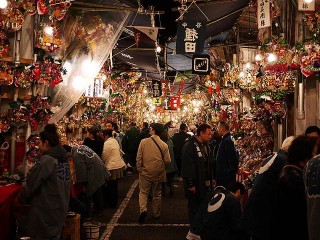Loading
Search
▼ Tori-No-Ichi (Day of the Rooster): a Guide to Tokyo's Lucky Festival
- Category:Festival
Location: Otori shrines, Asakusa, Tokyo, Japan
Dates: Every 12 days in November
Level of participation: 2 – buy a rake for luck
Taking place on the Days of the Rooster (according to the Chinese zodiac), this event normally happens twice a year. In the occasional years when it occurs three times, superstitious doomsayers believe there will be many fires. However, it’s invariably an upbeat occasion, where the festival-goers visit Otori shrines to ask for abundant harvests and shedloads of sales. Markets spring up around the shrines – the largest, in Tokyo’s Asakusa area, attracts tens of thousands of visitors to some 200 stalls.
A popular item to buy is a lucky kumade, a rake made of bamboo and adorned with charms. Hoping to keep raking in the wealth, some visitors fork out for a slightly bigger kumade each year. Traditionally, buyer and seller seal the deal with a ritual known as tejime, where they rhythmically clap their hands in harmony.
Ringing with claps and shouts, the markets are atmospheric places and many people turn up for a wander and some eats such as Yatsugashira potatoes, said to aid fertility.
Essentials: The festival takes place at some 30 shrines in Tokyo.
Local attractions: Asakusa is on the site Yoshiwara, the red light district of the ancient, pleasure-seeking city Edo. The five-storey pagoda was built to honour comedians, among others.
Dates: Every 12 days in November
Level of participation: 2 – buy a rake for luck
Taking place on the Days of the Rooster (according to the Chinese zodiac), this event normally happens twice a year. In the occasional years when it occurs three times, superstitious doomsayers believe there will be many fires. However, it’s invariably an upbeat occasion, where the festival-goers visit Otori shrines to ask for abundant harvests and shedloads of sales. Markets spring up around the shrines – the largest, in Tokyo’s Asakusa area, attracts tens of thousands of visitors to some 200 stalls.
A popular item to buy is a lucky kumade, a rake made of bamboo and adorned with charms. Hoping to keep raking in the wealth, some visitors fork out for a slightly bigger kumade each year. Traditionally, buyer and seller seal the deal with a ritual known as tejime, where they rhythmically clap their hands in harmony.
Ringing with claps and shouts, the markets are atmospheric places and many people turn up for a wander and some eats such as Yatsugashira potatoes, said to aid fertility.
Essentials: The festival takes place at some 30 shrines in Tokyo.
Local attractions: Asakusa is on the site Yoshiwara, the red light district of the ancient, pleasure-seeking city Edo. The five-storey pagoda was built to honour comedians, among others.
- November 10, 2016
- Comment (0)
- Trackback(1)


